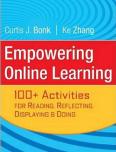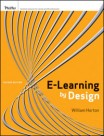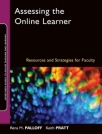The following books address the additional skill-set required by online education.

Bonk, Curtis and Ke Zhang. Empowering Online Learning: 100+ Activities for Reading, Reflecting, Displaying & Doing. San Francisco: Jossey-Bass, 2008. Print.
The book stresses using the R2D2 model of online activities/strategies: Read (auditory and verbal learners), Reflect (reflective and observational learners), Display (visual learners), and Do (tactile and kinesthetic learners). For each of these learning preferences, sample technology resources and tools (strategies) are presented. Quite helpful in creating online learning tools.
 Horton, William. E-Learning by Design. 2nd Ed. San Francisco: Pfeiffer, 2012. Print.
Horton, William. E-Learning by Design. 2nd Ed. San Francisco: Pfeiffer, 2012. Print.
A large resource (614 pages) that also includes online chapters, strengths include clear ideas on writing goals, objectives, and lessons. The book contains practical ideas for planning learning strategies, for assessing student needs, and designing assessment. It is also helpful for looking at the design and workings of an instructional website.

Ko, Susan and Steve Rossen. Teaching Online: A Practical Guide, 3rd Ed. New York: Routledge, 2008. Print.
Designed for university teachers, the book is a practical guide to creating online courses. Examples are included for each strategy and the authors offer multiple options for planning and setting up the course, designing instruction, using Web 2.0 tools, and assessment. It seems to be the most practical book for online education.

November, Alan. Empowering Students with Technology, 2nd Ed. Thousand Oaks, CA: Corwin Press, 2010. Print.
November covers a large area of online learning, beginning a discussion of literacies, of communication, of the Internet as a means of growing relationships, and of the need for teachers and students to find new ways to teach and learn. Of special note is the chapter on online learning, looking at how teachers can best facilitate especially in terms of looking at concepts and supporting the needs of the online student.
 Palloff, Rena M. and Keith Pratt. Assessing the Online Learner: Resources and Strategies for Faculty. San Francisco: Jossey-Bass, 2009. Print.
Palloff, Rena M. and Keith Pratt. Assessing the Online Learner: Resources and Strategies for Faculty. San Francisco: Jossey-Bass, 2009. Print.
The first part of the book discusses the basics of both assessment in general and the idea of online assessment, in terms of student assessment and course assessment. The second part covers specific and practical online assessment methods and strategies: rubrics, interactivity, authenticity, test and quiz development, portfolios, and wikis and blogs.
